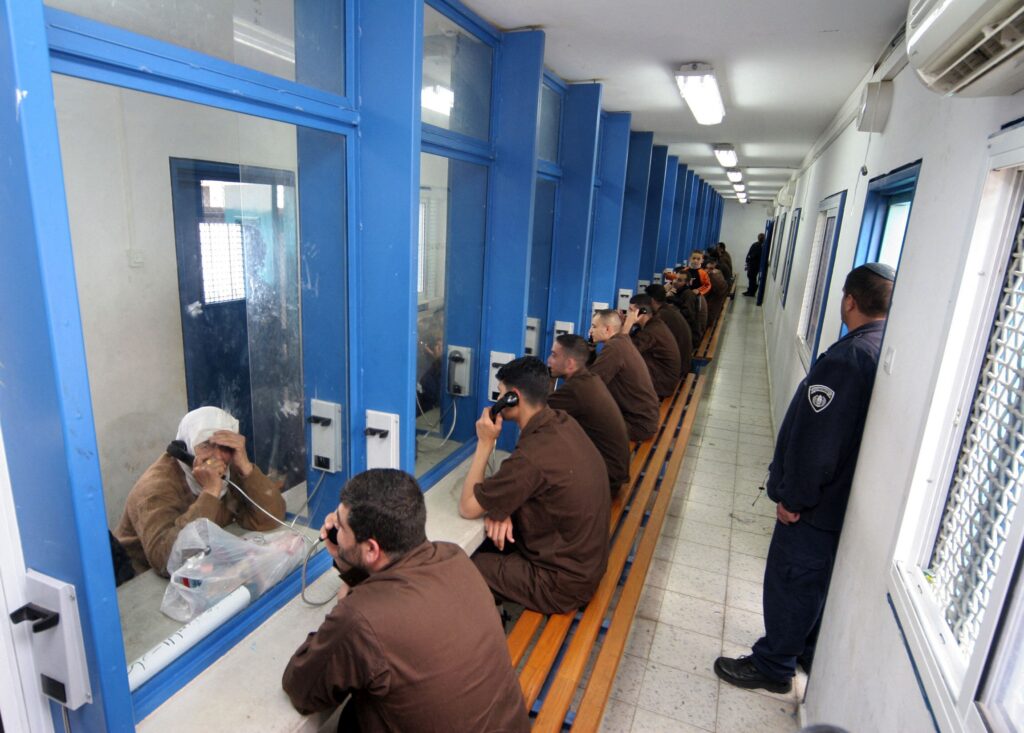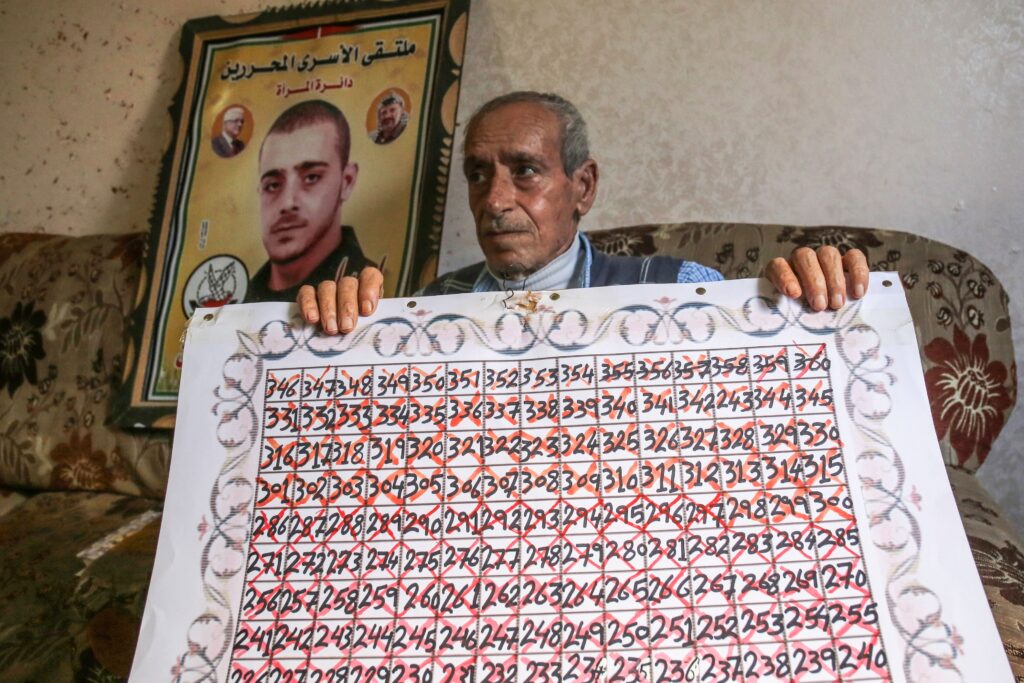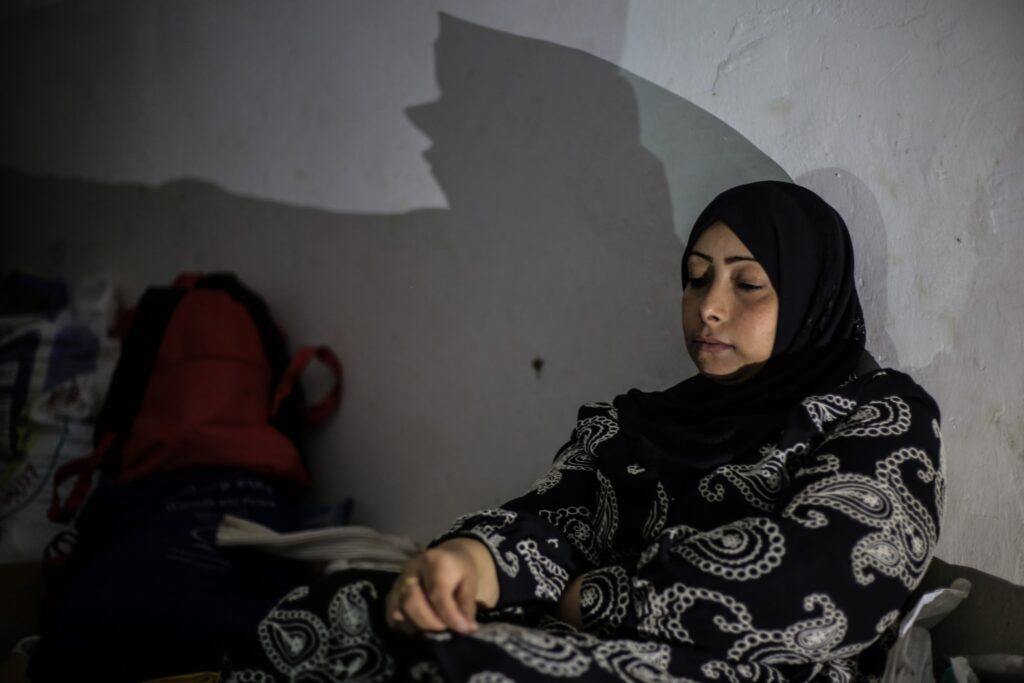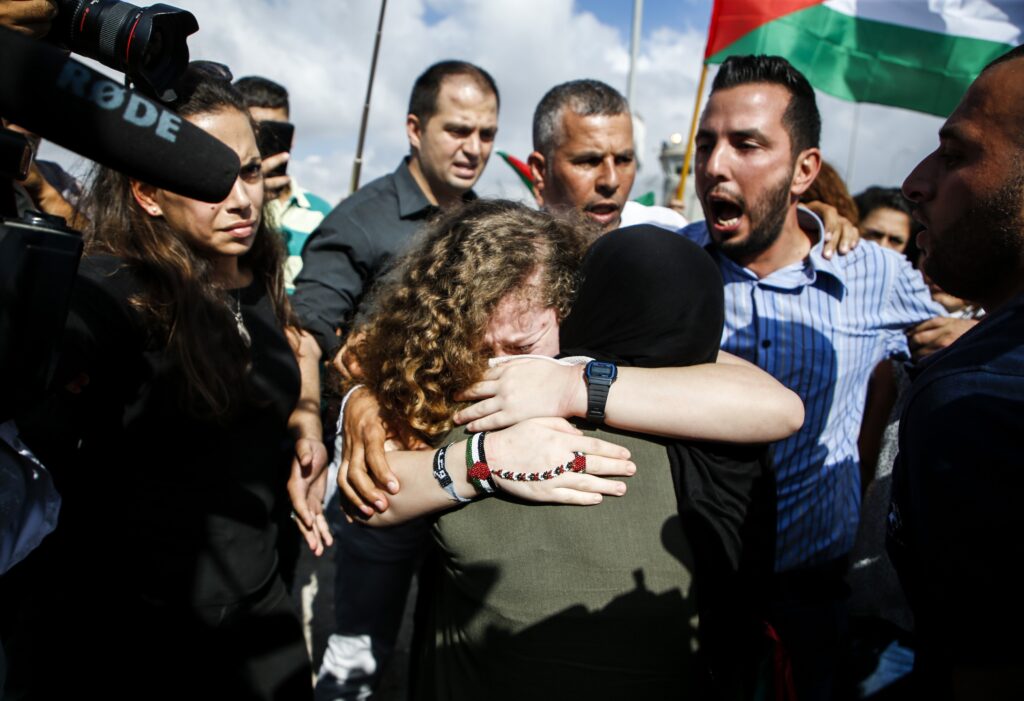How Israeli Prisons Terrorize Palestinians—Inside and Outside Their Walls
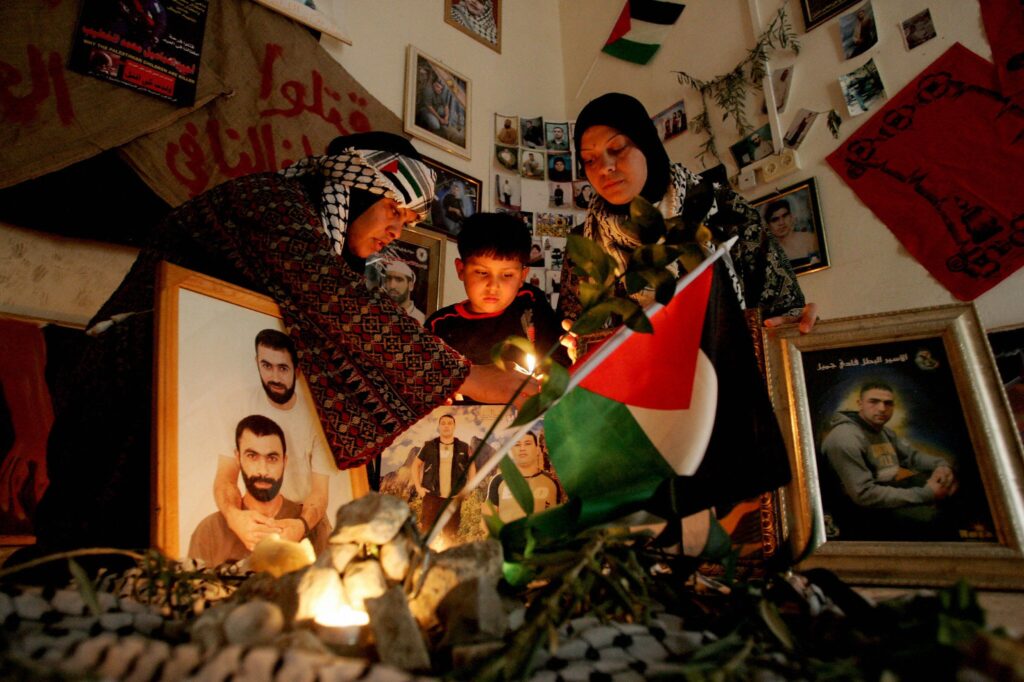
CAMERAS ON CARCERAL VIOLENCE
In December 2023, as Israel’s genocidal war on Gaza entered its third month, the Israeli occupying forces (IOF) released photos and videos of military trucks crammed with Palestinian captives: stripped to their underwear, kneeling, blindfolded, and with hands bound behind their backs.
While Israeli media boasted the images depict “Hamas terrorists surrendering in Gaza,” Palestinian and international organizations reacted with horror over the flagrant human rights abuses. Even the United States government, Israel’s main ally and a relentless weapons provider, expressed concern. But Israel defended the images, stressing they depict normal procedures when searching for dangerous “suspects.”
The IOF circulated the images to project an elusive sense of “victory” over an occupied population that has been subjected to decades of settler-colonial violence. But more significantly, this kind of carceral violence serves a broader purpose.
Through my ethnographic work in Palestine, Chile, and Colombia, I have traced how carceral regimes—the institutions and systems built around imprisonment—racialize and reengineer populations to bring forth obedience and passivity. As an anthropologist and Palestinian living in the West Bank, I both investigate and endure the reality of Israel’s carceral regime.
Israeli prison practices are designed not only to detain multitudes—an estimated 1 million Palestinians since 1948—but to portray Palestinians as “dangerous” subjects worthy of punishment. The occupiers assume the looming threat of torture, violence, and imprisonment will snuff Palestinian acts of resistance.
But despite the ever-intensifying carceral violence, Palestinians continue to resist and hold hope for their long-awaited freedom.
A PRISONER FROM EVERY HOME
A popular saying in Palestine goes, “In every Palestinian home, you would find a prisoner or a former prisoner.” This is not far from reality.
Palestinian human rights organizations have shown that one in five Palestinians has been arrested and charged in Israeli military courts since the occupation of the West Bank and the Gaza Strip in 1967. Each year, this figure adds approximately 500–700 Palestinian children, some as young as 12, who are detained and prosecuted in Israeli military courts.
During the ongoing genocidal war across historic Palestine, Israeli carceral violence and arrest campaigns have only intensified. In the months prior to October 7, an approximate 5,200 Palestinians were detained in Israeli prisons. As of mid-March, that number exceeds 9,000. Over the past five months alone, Israeli occupying forces have arrested over 7,600 Palestinians in the West Bank, in addition to an unknown number of detained Gazans.
Conditions are worsening for the imprisoned. Immediately following the war’s outbreak, the Israel Prison Service (IPS) placed prisoners in total isolation, prevented them from leaving their cells, and restricted access to water and electricity. The agency ceased providing what had already been poor-quality medical care and has dispensed inadequate food, enacting a starvation campaign against prisoners. Guards inflict violence, torture, and degrading treatment such as reportedly forcing captives to “bark.”
IPS also banned visits for family members and delegates from the International Committee of the Red Cross, and severely restricted lawyer visits—cutting prisoners off from the outside world.
LAWS SANCTIONING SUFFERING
My research inside Israeli military courts and prison visitation rooms—both as an anthropological researcher and a family member of prisoners—highlights the systematic nature of this violence and its justification through legal codes. Through an intricate web of military laws and orders, Palestinians become racialized—a sociopolitical process through which groups are seen as distinct “races” ordered in a social hierarchy.
The Israeli carceral system racializes Palestinians as inherently “criminal” and thus deserving of punishment.
Following the occupation of the West Bank and the Gaza Strip in 1967, the Israeli military was vested with the ultimate authority of government, legislation, and punishment over the Palestinian population. This includes prosecuting Palestinians in military courts and charging them under the nearly 1,800 military orders that govern every aspect of daily life: conduct, property, movement, evacuation, land seizures, detention, interrogation, and trial.
The orders include provisions for indefinitely detaining Palestinians without charge or trial through a policy inherited from British colonial practices. Over 3,500 Palestinians are being held in this state as of early March. Other provisions regulate the arrest and interrogation of Palestinians and how long they can be denied lawyer visits.
With a near 100 percent conviction rate, Israeli military courts hand down absurdly high sentences, sometimes amounting to dozens of life sentences. Torture inside Israeli prisons and detention facilities is sanctioned by Israeli High Court of Justice (HCJ) rulings that permit the exercise of violence under pretexts of “security” and protecting “public order.”
Enmeshed within this carceral reality is Israel’s labeling of most Palestinian prisoners as “security prisoners.” This designation masks the political nature of their imprisonment and sanctions violations against them. As opposed to Palestinian “security prisoners,” incarcerated Jewish settler-citizens receive rights such as making telephone calls, going on home visits under guard, the possibility of furlough, and conjugal visits. These rights are denied to the mostly Palestinian security prisoners, who are viewed and racialized from the start as criminals.
RECOUNTING THEIR TORTURE
Much like the December 2023 images of Gazans stripped and bound, Israel’s carceral violence aims to instill defeat and submission among Palestinian prisoners and the entire occupied population.
My interviews bear this out. In 2021, I spoke with Leila and Nadia, two Palestinian students who endured a monthlong, brutal interrogation at al-Mascobiyya Interrogation Center in Jerusalem. [1] [1] These two names have been changed to protect people’s privacy. They were then indicted in the Ofer military court on charges related to student activism.
When asked about the torture methods, Leila said, “At a certain stage, [the torture] stopped being painful. The pain continued inside me, of course.”
She went on: “You can’t defend yourself in the interrogation room. I was hearing people’s screams, and I clearly was not able to offer them help in any way.”
Similarly, Nadia was forced to witness other detainees being tortured to “teach her a lesson”: This could be you if you do not confess. She said the purpose of interrogation was “to kill your humanity. … They would tell me, ‘This is the regular process. If you teach your path to your kids, then the same exact thing would happen to them.’”
Since the war began, despite obstacles to communicating with lawyers and family members, Palestinian prisoners have managed to reveal their conditions.
In a letter shared with me, an individual who has spent over 25 years in Israeli prisons described the current conditions as similar, if not harsher, than the physical torture he has previously endured in Israeli interrogation centers. He hears other prisoners scream in agony from beatings—all while locked in his cell, only allowed to leave twice for lawyer visits since the war began.
IMPRISONED IN LIFE AND DEATH
Early March reports point to the death of 27 Gazan detainees in Israeli detention facilities since October 7. And further reports record an additional 10 and possibly 13 Palestinian detainees’ deaths as of publication who died in Israeli prisons due to torture, violence, and systematic medical neglect since that date.
The Israeli carceral system even attempts to control Palestinian death. Israel refuses to release the bodies of hundreds of Palestinians held in its military cemeteries and refrigerators at the National Center of Forensic Medicine. Legal rulings permit the withholding of Palestinian bodies as bargaining chips in negotiations or potential prisoner exchanges.
One of the detained bodies belongs to Anis Dola, a Palestinian prisoner who died due to health complications following his participation in a hunger strike in 1980. The Israeli authorities declared his body as “missing,” despite numerous testimonies that attest to his death in captivity.
Drawing from anthropological work on the “othering” of colonized populations, I view these carceral practices as central to Israel’s racialization of Palestinians in ways that justify all forms of violence against them. The policies and laws buttress beliefs that Palestinians are the subjects of Jewish settlers.
By this view, Palestinians are inherently dangerous—not only to the Zionist project, but to world “civilization.”
INDOMITABLE DREAMS
And yet Palestinians continue to resist the settler-colonial regime that racializes, dehumanizes, and tries to erase them. Consider the counterimages of Palestinian children and women released through a November 2023 prisoners’ exchange. The scenes, which show family reunions and Palestinians gathering to greet released prisoners, highlight that imprisonment—and threats of imprisonment—have not broken an occupied population’s struggle for liberation.
This refusal to submit to power and violence was echoed by a Palestinian prisoner who recently entered his 23rd year in captivity. His lawyer recounted to me a conversation they had in Ofer Prison. Behind bulletproof glass, frail and exhausted, the prisoner described dreams of freedom through the telephone mounted in the prison’s visitation room.
He said: “I want to be released back to our land. I want to go back to my house and my street. I want to walk in the streets where I spent my childhood. I want to relive my memories with my friends and walk alongside my wife in the same streets we used to walk decades ago. I want to go to my parents’ house [who passed away while he was imprisoned] and remember the food they used to make for us.”
Happening inside and outside prisons, Israel’s relentless violence and torture have not broken Palestinians. We continue to dream and work for liberation.































